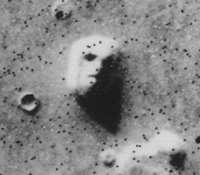This is an old revision of this page, as edited by 193.203.82.194 (talk) at 11:35, 11 October 2007. The present address (URL) is a permanent link to this revision, which may differ significantly from the current revision.
Revision as of 11:35, 11 October 2007 by 193.203.82.194 (talk)(diff) ← Previous revision | Latest revision (diff) | Newer revision → (diff)
Cydonia Mensae is an albedo feature (region) on Mars. It lies in the planet's northern hemisphere in a transitional zone between the heavily-cratered regions to the South, and relatively smooth plains to the North. Some planetologists believe that the northern plains may once have been ocean beds and that Cydonia may have been a coastal zone (though this is still uncertain). Cydonia is covered in numerous mesas, some of which have attracted both scientific and popular attention.
The Face on Mars



One of the Cydonian mesas, situated at 40°75' north latitude and 9°46' west longitude, took on the striking appearance of a humanoid Face on Mars in a photo taken by Viking 1 on July 25, 1976. Some commentators, most notably Richard C. Hoagland, believe it to be evidence of a long-lost Martian civilization along with other features they believe are present, such as apparent pyramids, which they argue are part of a ruined city. Image analysis of the early Viking images led a few researchers to suggest that the features of the Face might not be an accidental consequence of viewing conditions.
However, today it is generally accepted by mainstream science to be an optical illusion, an example of pareidolia. NASA has always stated, without any research performed, that "a detailed analysis of multiple images of this feature reveals a natural looking Martian hill whose illusory face-like appearance depends on the viewing angle and angle of illumination".
Originally, eighteen images of the Cydonia Mensae region were taken by the Viking 1 and 2 orbiters, but only seven have resolutions better than 250 m/pixel (820 ft/pixel). The other eleven images have resolutions worse than 550 m/pixel (1800 ft/pixel) and are virtually useless for studying the feature. Of the seven good images, the lighting and time at which two pairs of images were taken are so close as to reduce the number to five usable, distinct images. The Mission to Mars: Viking Orbiter Images of Mars CD-ROM image numbers are: 35A72 (VO-1010), 70A13 (VO-1011), 561A25 (VO-1021), 673B56 & 673B54 (VO-1063), and 753A33 & 753A34 (VO-1028).
Since September 2006, a succession of new data from the Cydonia region have been published by the European Space Agency and the HiRISE team. These have included photographs taken by the Mars Express probe and the Mars Reconnaissance Orbiter, and a 3D animation of the "Face on Mars" using a combination of digital data from the High Resolution Stereo Camera (HRSC) on the Mars Express probe and the Mars Orbiter Camera (MOC) on board NASA's Mars Global Surveyor. In contrast to the relatively low resolution of the Viking images of Cydonia, these new platforms afford much improved resolution. For instance, the Mars Express images are at a resolution of 14 m/pixel (46 ft/pixel) or better.
Cydonia and the Face on Mars appear frequently in popular culture, including feature films, television series, videogames and even music. Astronomer Carl Sagan criticized many conclusions people have made about it in his book The Demon Haunted World.
See also
- Galle, a Martian crater also known as the "Happy face" or "Smile" of Mars.
- Life on Mars
- Richard C. Hoagland
References
- Head, J.W., Kreslavsky, M., Hiesinger, H., Ivanov, M., Pratt, S., Seibert, N., Smith, D.E. and Zuber, M.T. (1998). Oceans in the past history of Mars: Tests for their presence using Mars Orbiter Laser Altimeter (MOLA) data. Geophysical Research Letters 25, 4401-4404.
- Malin, M. C. and Edgett, K. S. (1999). Oceans or seas in the Martian northern lowlands: High resolution imaging tests of proposed coastlines. Geophysical Research Letters 26, 3049-3052.
- ^ Carlotto, M. J. (1988) Digital Imagery Analysis of Unusual Martian Surface Features. Applied Optics 27, 1926-1933.
- "The Face on Mars, Viking Project". NASA website. Retrieved 2007-04-26.
- Mission to Mars: Viking Orbiter Images of Mars website, NASA Jet Propulsion Laboratory; raw data in IMQ (ImageQ) format can be downloaded from these links: 35A72, 70A13, 561A25, 673B56, 673B54, 753A33, 753A34. Retrieved on 20 September 2007.
- "Cydonia - the face on Mars, 3D rendering of Mars Express imagery". ESA website. Retrieved 2007-04-26.
- "Popular Landform in Cydonia Region". HiRISE website. Retrieved 2007-04-26.
- "Cydonia's 'Face on Mars' in 3D animation using Mars Global Surveyor imagery". ESA website. Retrieved 2007-04-26.
- For example: Film - Mission to Mars (2000); TV series - The X-Files ("Space", 1993), Futurama ("Where The Buggalo Roam", 2002); Videogames - Zak McKracken (1988), X-COM: UFO Defense (1993); Music - Telemetry of a Fallen Angel by Cruxshadows (1995), "Knights of Cydonia" by Muse (2006).
External links
Astronomy
- Viking Project, NASA
- Mars Express, ESA (NASA page)
- Mars Global Surveyor, NASA
- High-resolution images of Cydonia, Mars Express orbiter
- Astronomy Picture of the Day 25-9-06, recent visual of the Face on Mars
- Astronomy Picture of the Day 26-9-06, recent visual of the Cydonia region (including the Face on Mars)
- Discussion of MOC and "Face on Mars", Malin Space Science Systems (also, Face on Mars)
- Cydonia Mensae at Google Mars
- Independently processed Cydonia Images
"Face on Mars" as artifact
- The Enterprise Mission, Hoagland's official website
- The Hidden Records, official website of a book by Wayne Herschel
- Face on Mars, entry in the Skeptic's Dictionary
- Hoagland debunking at Bad Astronomy, a discussion of the science and pseudoscience of Cydonia
- The exact position of the Face on Mars on Geody, linked to NASA World Wind